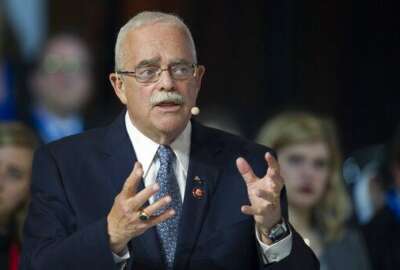

A $1 billion increase in the Technology Modernization Fund gives its board an opportunity to take on multi-agency IT projects that have become more urgent under...
Congress is making a big investment in the Technology Modernization Fund and giving the Biden administration the resources necessary to take on longer-term, more complex IT modernization projects than what the fund could previously support.
The $1.9 trillion American Rescue Plan Congress passed earlier this month adds $1 billion to the TMF, a revolving fund that awards five-year loans to agencies for IT modernization projects that demonstrate a strong return on investment.
The increase in funding gives the TMF Board an opportunity to not just fund more projects, but take on multi-agency IT work that’s become more urgent under the COVID-19 pandemic.
The Alliance for Digital Innovation is leading nine other industry associations in a letter calling on the Biden administration to use the TMF to “unleash necessary, and long overdue” investments in federal IT.
The associations tell Federal Chief Information Officer Clare Martorana, and the acting heads of the Office of Management and Budget and the General Services Administration, that the current process for agencies to submit and repay the TMF has discouraged agency CIOs from submitting plans.
The whole process, they add, is “unnecessarily complicated and restrictive” to support projects that address multi-agency opportunities.
ADI Executive Director Matthew Cornelius, a former senior technology and cybersecurity adviser at OMB who led efforts to stand up the TMF, said the $1 billion increases the likelihood of the TMF Board approving larger and more complex legacy modernization projects.
Cornelius said the funding also gives the Biden administration an opportunity to address the huge “technical debt” across agencies and begin funding multi-agency modernization projects.
“There’s a real chance for OMB and GSA to take all these lessons learned over the past year of responding to the COVID-19 pandemic, and look at these sort of multi-agency investments or governmentwide, enterprise-wide investments, and really push the money to where those needs are the greatest for the most,” Cornelius said in an interview.
The pandemic highlighted areas in need of governmentwide, multi-year investment – including digital identity and identity management to support remote work, secure data sharing between agencies, and investment in the 21st Century Integrated Digital Experience Act (IDEA), which sets goals for agencies to improve their websites, adopt electronic signature capabilities and improve digital services.
“There’s money that can go to that to really make sure that we’re getting the best and most effective information and services out to citizens, at a time when they’re relying on the government more than they might have ever thought of prior,” Cornelius said.
Increased TMF funding could also bolster cybersecurity shared services, whether that’s supporting the Cybersecurity and Infrastructure Security Agency’s new cyber threat-hunting capabilities or supporting the governmentwide vulnerability disclosure program that OMB rolled out last year.
“That’s another place where the government’s all going to move in one direction, and they’re all going to have common challenges and opportunities,” Cornelius said.
Cornelius said the increase in funding also gives GSA’s Technology Transformation Services an opportunity to invest more into the program management office that staffs the TMF Board and helps identify and bring forward projects.
Incoming staff would include technologists, digital services experts and acquisition professionals that will help match agencies and industry together on modernization projects.
The staff, Cornelius said, should also hold more regular meetings with industry to share use cases, discuss emerging trends and bring vendors up to speed on how they can participate in the “opaque” TMF process.
“There’s not a lot that people understand about how the TMF works, why the board chooses its projects and how you even submit projects,” he said.
With increased resources, the TMF could also take a crack at longer-term projects like GSA’s NewPay, a governmentwide payroll and attendance system, or OMB MAX, the system the agency uses to collect budget data and complete budget submissions.
Cornelius said these projects are necessary investments, but perhaps not the sorts of low-risk, high-reward projects that the TMF Board has favored so far.
“The best way to show the impact of the TMF, and the best way to show return on investment is to move the money quickly to high-priority projects and start building on success after success. You can focus on ‘I need to recoup all of the amounts for the money that I have right now,’ or you can demonstrate the real value and utility of the TMF, and why it is so different than any other appropriation at any other agency for modernization out there, and then go back to the appropriators, make your case and try to get more money in the subsequent budget and appropriation cycles,” Cornelius said.
Building a solid portfolio of success stories, he added, will give the Biden administration a compelling argument for Congress to keep funding the TMF at these or higher levels, or granting multi-year funding to agency-specific projects. But unless agencies can demonstrate results quickly, Cornelius said lawmakers will hesitate to make another billion-dollar investment in federal IT.
“This is really the put-up-or-shut-up moment, where the model has to work, where the TMF has to do everything we’ve always wanted it to do. If they’re able to show success, I think it’s going to allow them to continue to get more money in the TMF, both through additional appropriations, as well as potential repayments. And continue to make some of these bigger, more difficult, but ultimately more beneficial investments that have been long overdue, because they’re just too complicated and too hard to do through a normal 12-month budget and appropriations timeline,” he said.
Copyright © 2024 Federal News Network. All rights reserved. This website is not intended for users located within the European Economic Area.
Jory Heckman is a reporter at Federal News Network covering U.S. Postal Service, IRS, big data and technology issues.
Follow @jheckmanWFED


